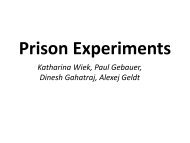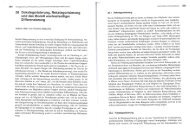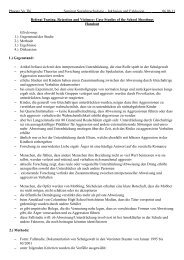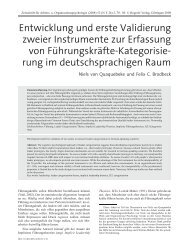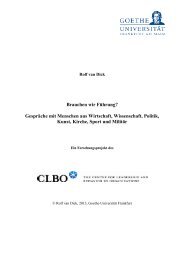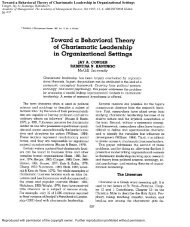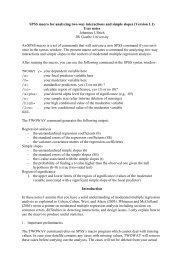Social Identity Theory and Self-categorization Theory: A Historical ...
Social Identity Theory and Self-categorization Theory: A Historical ...
Social Identity Theory and Self-categorization Theory: A Historical ...
Create successful ePaper yourself
Turn your PDF publications into a flip-book with our unique Google optimized e-Paper software.
216 <strong>Social</strong> <strong>Identity</strong> <strong>Theory</strong> <strong>and</strong> <strong>Self</strong>-<strong>categorization</strong> <strong>Theory</strong><br />
Another point of evolution concerns the relationship between the<br />
individual <strong>and</strong> the group. <strong>Social</strong> identity theorists worked hard to<br />
distinguish themselves from individualistic <strong>and</strong> reductionist approaches<br />
to group processes. A consequence of this was an implicit assumption<br />
that the collective self was a primary basis for self-definition, <strong>and</strong> a<br />
suspicion of analyses that assumed individual-based motives for group<br />
behaviour. Recently, theorists have been playing ‘catch-up’ trying to<br />
articulate in a more nuanced way the intimate interconnections between<br />
desires for individual distinctiveness, group belonging, <strong>and</strong> self-enhancement,<br />
<strong>and</strong> how the expression of these desires are shaped through culture<br />
(Hornsey & Jetten, 2004). One consequence of this is a subtle withdrawal<br />
from the notion that the relationship between the personal <strong>and</strong><br />
collective self is ‘antagonistic’. There is also a growing awareness that<br />
individuals <strong>and</strong> groups mutually influence each other; individuals are<br />
shaped <strong>and</strong> influenced by group norms, but group norms are actively<br />
contested, discussed, <strong>and</strong> shaped by individuals (Hornsey, 2006; Postmes<br />
& Jetten, 2006; Postmes, Spears, Lee, & Novak, 2005).<br />
In terms of the external evolution of the theory, social identity research<br />
has seen expansion both in its choice of dependent measures <strong>and</strong> in its<br />
domains of influence. In terms of its dependent measures, there has been<br />
a strong emphasis in recent years on applying social identity principles to<br />
group-based emotions, <strong>and</strong> to track how these emotions predict intergroup<br />
behaviour (Smith, 1993). Emotions that have proved particularly fertile<br />
grounds for research include shame (Ellemers, Doosje, & Spears, 2004),<br />
collective guilt (Doosje, Branscombe, Spears, & Manstead, 1998), <strong>and</strong><br />
intergroup schadenfreude (Leach, Spears, Branscombe, & Doosje, 2003).<br />
There is also a growing emphasis on the relationship between social identity<br />
<strong>and</strong> memory for (Sahdra & Ross, 2007), <strong>and</strong> forgiveness of (Hewstone<br />
et al., 2004), historical atrocities. The work on intergroup forgiveness<br />
includes the first forays into examining the psychological meaning of the<br />
most inclusive level of identity proposed by SCT: the human identity<br />
(Wohl & Branscombe, 2005).<br />
Finally, the last decade has seen the social identity approach inform<br />
<strong>and</strong> transform fields that intersect or lie outside traditional social psychological<br />
analyses of group processes. For example, by sharpening our<br />
underst<strong>and</strong>ing of norms, the social identity approach has revised how<br />
we predict attitudes <strong>and</strong> behaviours, insights that have had a tremendous<br />
impact on a range of applied domains (Terry, Hogg, & White,<br />
2000). <strong>Social</strong> identity ideas are also beginning to leave an imprint on<br />
our underst<strong>and</strong>ing of communication (Hogg & Reid, 2006), justice<br />
(Tyler, Degoey, & Smith, 1996), <strong>and</strong> political psychology (Brewer,<br />
2001). But nowhere has the impact of the social identity approach been<br />
more dramatic than in the field of organizational psychology (see, for<br />
example, Haslam, 2004; Hogg & Terry, 2000). At the time of writing,<br />
Ashforth <strong>and</strong> Mael’s (1989) discussion of social identity in organizations<br />
© 2008 The Author <strong>Social</strong> <strong>and</strong> Personality Psychology Compass 2/1 (2008): 204–222, 10.1111/j.1751-9004.2007.00066.x<br />
Journal Compilation © 2008 Blackwell Publishing Ltd



